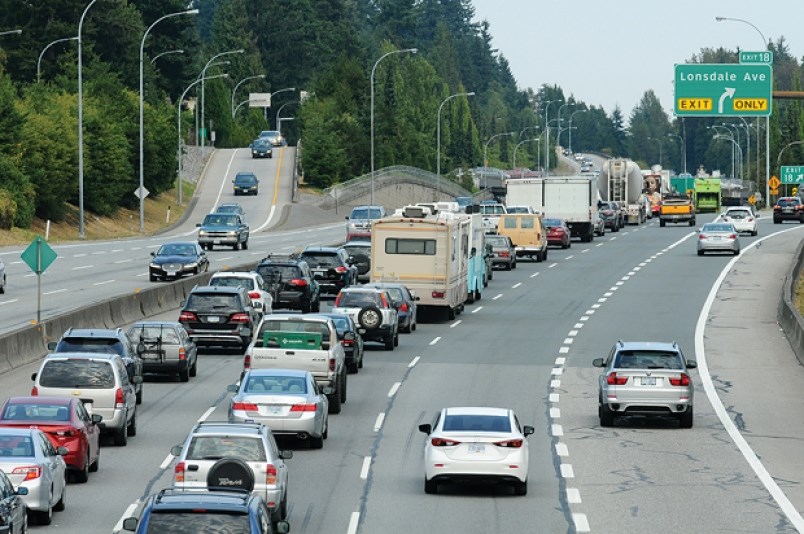Transportation on the North Shore seems like a highly controversial issue, with many residents, including politicians, holding a number of positions.
It appears, however, that most people agree navigating east to west across the North Shore at certain times in the day can be a nightmare.
“It can often add an hour to an otherwise quick 20-minute commute” says one senior who volunteers on the North Shore, usually in the Lonsdale corridor, but lives in the Deep Cove area.
In North Shore News article from September, 2018, TransLink’s vice-president of transportation and planning Geoff Cross is quoted as saying: “There are just not a lot of alternatives. The grid does not have very many options for east-west travel, both from a congestion perspective and from a reliability perspective. If something happens on either one of those main east-west corridors, whether it be Upper Levels or on Main and Marine, then you can have extreme congestion events. … It doesn’t have the same resiliency as places within the region where you have parallel routes that act as options for people.”
In a report made public last year, called Integrated North Shore Transportation Planning Project, several solutions were suggested, with one being to get people out of their personal vehicles and onto alternative transportation options. In a News article from September, 2018, North Vancouver-Lonsdale MLA Bowinn Ma says the main goal of INSTPP is to get people from Point A to Point B, not necessarily their cars.This could mean moving residents about using public transportation such as buses, walking or cycling, car or ride-sharing, seniors’ centres’ sponsored buses and other programs.
For seniors, transportation is crucial if they wish to stay active, independent and involved in their communities. Transportation is a social determinant of health and is fundamental to an independent, socially involved and active life for older adults.
In a 2011 Seniors Today Survey, a report sponsored by Lionsview Seniors’ Planning Society, it showed the seemingly contradictory evidence that suggests seniors would choose walking as their preferred form of transportation but even though most relied on their own vehicles as their most used way of getting around the North Shore. (At that time, the respondents also reported little difficulty driving to destinations on the North Shore.)
A 2018 report, Seniors Transportation: Affordable, Appropriate and Available from the B.C. seniors’ advocate reflects the fact that “getting a person from point A to B does not totally capture the transportation needs of frail and vulnerable seniors. Many seniors may have the physical ability to take a bus or use HandyDART, but they have cognitive challenges that require someone to accompany them or, their physical frailty requires someone to assist them throughout their trip.”
As seniors age they may require a variety of ways to get around including public transportation, ride-sharing, taxis, HandyDART, being driven by a friend, relative or caregiver, accessing a shuttle bus, walking, or cycling.
But many of these transportation methods have their problems. The Seniors Today survey found that 20 per cent of their North Shore seniors reported mobility issues which made public transportation difficult to use.
Public transportation is not always located close to where seniors live. As the B.C. seniors advocate’s transportation report states, some seniors may find it difficult to use public transportation if they have some form of cognitive delay or mobility issue. Also, bus stops may not have washrooms nearby or covered benches to sit on while waiting for a bus – both amenities seniors on the City of North Vancouver’s Seniors Action Table have said were necessary.
For many North Vancouver seniors who would like to walk, they find there is not enough covered seating at regular intervals and that there is a shortage of accessible washrooms. Seniors may also have trouble navigating around sandwich boards, outdoor patios, skateboarders and bikes on sidewalks.
The Seniors Today survey also found that most seniors didn’t bike because of the North Shore’s hills, weather and problematic bike lanes.
Seniors who are transitioning from driving their car may have some fears about using public transportation.
How then, to get seniors out of their cars and onto to other modes of transportation such as the transit system?
Silver Harbour Seniors’ Activity Centre hosted a two-part series of Transit Training for Seniors and a Drivers’ Transitioning Workshop with ICBC, TransLink, HandyDART and North Vancouver RCMP, and participants are now applying what they learned.
A group started with planning and organizing an outing to the airport in late November, 2018, with the next Transit Expedition scheduled for Westminster Quay on Thursday, Feb. 28 from 9:45 a.m. to 4:30 p.m.
There are other options for seniors who are trying to find alternative modes of transportation including using the buses run by organizations such as Silver Harbour and West Vancouver Seniors’ Activity Centre, Parkgate, the Better at Homes program, Capilano Services Society and North Shore Neighbourhood House.
As I have argued before, these bus programs could be better funded to make them more widely accessible for seniors.
Transportation planners clearly face many challenges on the North Shore. Let’s hope that the seniors community can be part of that planning process.
Margaret Coates is the co-ordinator of Lionsview Seniors’ Planning Society. She has lived on the North Shore for 48 years and has worked for and with seniors for 20 of those years. Ideas for future columns are welcome Email: lions_view@telus.net.
What are your thoughts? Send us a letter via email by clicking here or post a comment below.



